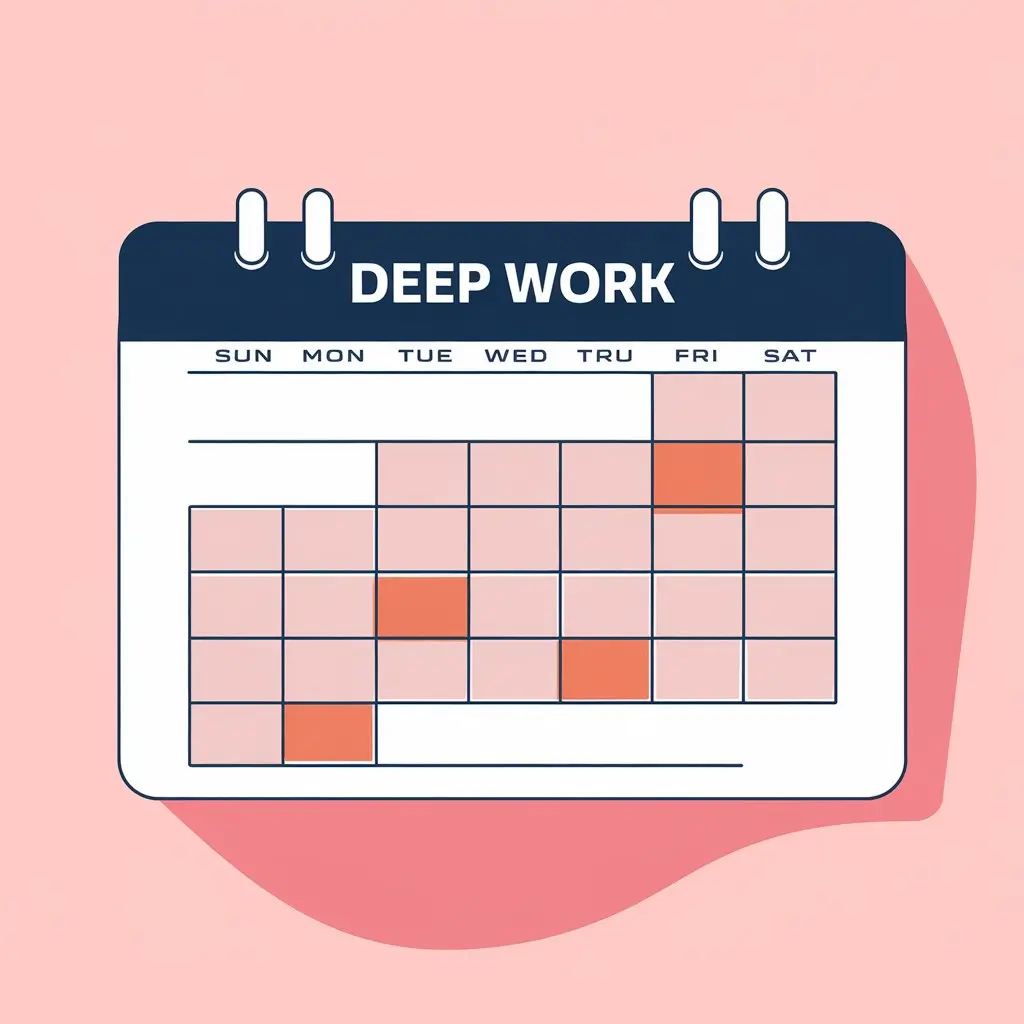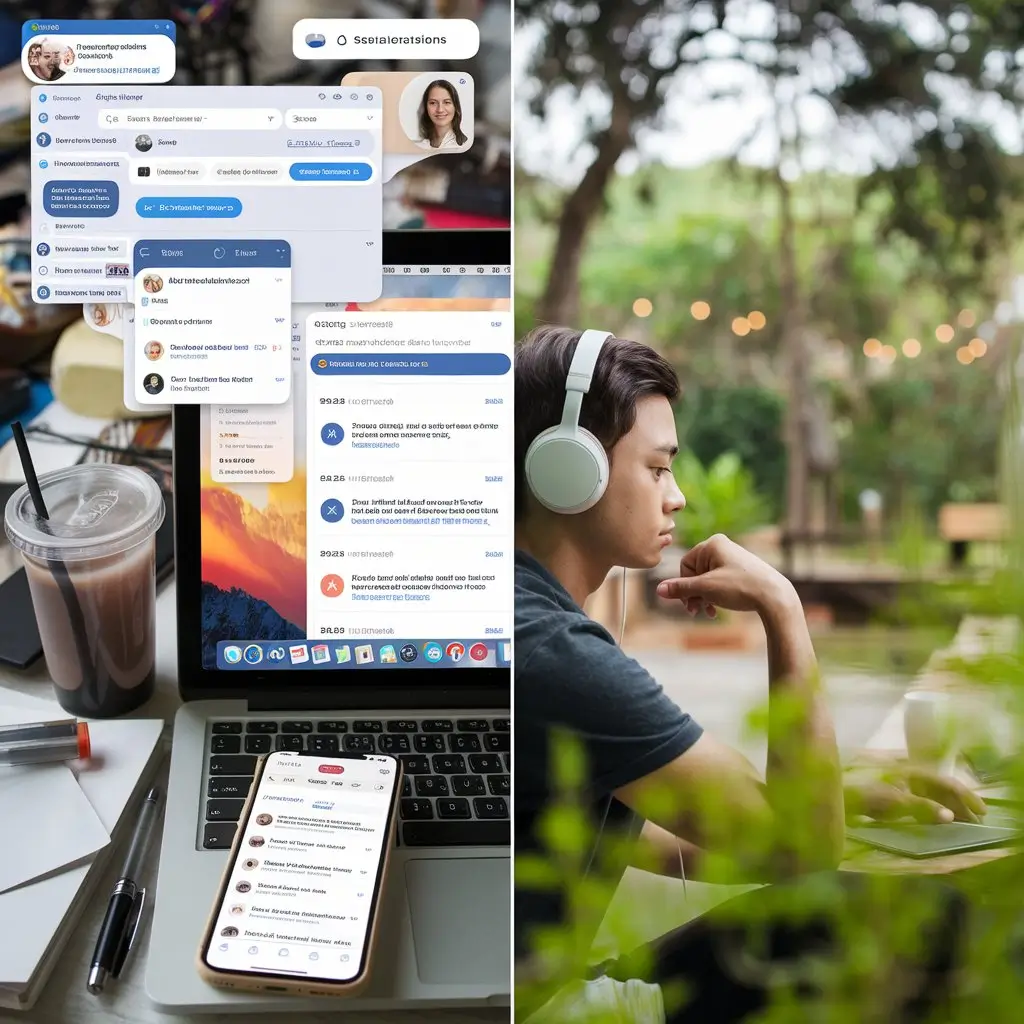In our fast-paced world, productivity is often equated with success. However, the way we approach our work can significantly impact the quality of our output and our overall well-being. Two popular approaches to managing tasks are deep work and multitasking. Understanding these concepts is crucial for anyone looking to enhance their productivity and achieve personal and professional goals.
Understanding Deep Work
Definition of Deep Work
The academics described by Cal Newport in “Deep Work: Rules for Focused Success in a Distracted World” label deep work as sustained focus on difficult intellectual challenges. Deep work presents itself as an essential mindset which requires maximum mental concentration to yield major accomplishments. A person practicing deep work maintains continuous focus on activities demanding critical thinking skills together with creative problem-solving abilities and analytical thought. In contrast to shallow work, tasks that are logistical or administrative in nature, deep work allows individuals to produce high-quality output and innovative ideas.
Benefits of Deep Work
The advantages generated by deep work produce positive effects which extend through professional developments while simultaneously enhancing personal accomplishments. Some of the key benefits include:
- Enhanced Concentration and Creativity: Deep work fosters an environment where distractions are minimized, allowing individuals to tap into their creative potential. When fully immersed in a task, the brain can make connections and generate ideas that may not surface in a distracted state. This heightened focus leads to breakthroughs and innovative solutions to complex problems.
- Improved Quality of Work: The depth of focus that deep work demands translates into higher-quality results. When individuals dedicate uninterrupted time to their tasks, they can refine their thoughts and approaches, leading to thorough and polished outcomes. This quality often yields better results in less time compared to multitasking or shallow efforts.
- Long-term Skill Development: Engaging in deep work regularly contributes to skill mastery over time. By consistently pushing cognitive boundaries, individuals can develop expertise in their chosen fields. This commitment to deep work not only enhances current capabilities but also prepares individuals for future challenges and opportunities.
- Increased Satisfaction and Fulfillment: Many people report feeling a sense of accomplishment and fulfillment after completing deep work sessions. The engagement in meaningful, challenging tasks can lead to a state of flow, where individuals lose track of time and feel fully immersed in their work. This sense of achievement contributes to overall job satisfaction and personal fulfillment.
Examples of Deep Work in Practice
Deep work can be observed in various fields and professions. Here are a few examples that illustrate its application:
- Authors and Writers: Successful authors often carve out dedicated time to write without interruptions. J.K. Rowling, for instance, famously wrote much of her Harry Potter series in quiet cafés, isolating herself from distractions to dive deep into her storytelling.
- Scientists and Researchers: In the world of academia, researchers frequently engage in deep work when conducting experiments, analyzing data, or writing scholarly papers. This level of focus is essential for producing high-quality research that contributes to the advancement of knowledge.
- Software Developers and Engineers: In tech, deep work is crucial for coding and developing complex software systems. Engineers often reserve blocks of time to write code, troubleshoot issues, and innovate new features without the constant interruptions that come from a multitasking environment.
- Artists and Creatives: Many artists and designers find that deep work allows them to explore their creativity fully. By dedicating time to sketch, paint, or conceptualize without distractions, they can produce work that reflects their true artistic vision.
Cultivating Deep Work Habits
To reap the benefits of deep work, individuals must cultivate habits that support this focused approach. Here are some strategies to develop deep work practices:
- Establish particular objectives for your deep work periods before you begin. Your motivation together with your focus remain strong when you define your specific goals ahead of time.
- Schedule Deep Work Time: Allocate dedicated time blocks in your calendar for deep work. Treat these sessions as important appointments that should not be interrupted.
- Limit Distractions: Create an environment conducive to deep work by minimizing distractions. This may involve turning off notifications, using apps that block distracting websites, or finding a quiet space to work.
- Meditate on a regular basis as part of mindfulness practice to build up your focus skills. Mindfulness can enhance your awareness of distractions and help you refocus when your attention wanders.
Understanding Multitasking
Definition of Multitasking
Multitasking refers to the ability to handle multiple tasks or activities simultaneously or to switch quickly between them. In a modern context, it often involves managing various responsibilities, such as responding to emails, attending meetings, and completing tasks, all within the same time frame. The practice of multitasking generates minimum productivity when it divides attention between various tasks which results in reduced workflow quality.
Myths and Misconceptions about Multitasking
The general misconception about multitasking has helped to spread its popularity through several widespread myths.
- Myth 1: Multitasking Increases Productivity: Many people believe that juggling several tasks at once boosts overall productivity. However, research indicates that multitasking can actually decrease efficiency and increase the time needed to complete tasks. Focus becomes difficult for the brain when trying to perform two demanding tasks at once thus it results in mistakes alongside gradual decrease in execution speed.
- Myth 2: Multitasking is Necessary in Today’s Fast-Paced World: In an era where we are constantly bombarded with information and demands, there is a common belief that multitasking is essential for keeping up. However, this mindset often results in stress and burnout, as individuals feel pressured to do more than they can handle effectively.
- Myth 3: Some People are Naturally Better at Multitasking: While it’s true that some individuals may appear to manage multiple tasks more smoothly, cognitive science suggests that our brains are not designed for true multitasking. Most people experience a decline in performance when attempting to juggle multiple complex tasks, regardless of their perceived aptitude for multitasking.
Impact of Multitasking on Productivity
The cognitive impact of multitasking is significant and has been widely studied. Here are some key findings:
- Cognitive Overload: When individuals switch between tasks, their brains experience a cognitive overload, leading to increased mental fatigue. This overload can impair decision-making, creativity, and problem-solving abilities, ultimately reducing productivity.
- Increased Errors: Multitasking often results in a higher rate of mistakes. Research has shown that when people try to perform two or more tasks that require attention, they are more likely to overlook details and make errors, which can lead to costly consequences in both personal and professional settings.
- Time Loss Due to Task Switching: Studies estimate that switching between tasks can reduce productivity by as much as 40%. This is due to the time required for the brain to refocus on a new task. Each time a person shifts focus, there’s a lag in processing the new information, which cumulatively adds up throughout the day.
- Negative Effects on Mental Health: Constant multitasking can lead to increased stress and anxiety levels. The pressure to perform multiple tasks can create a sense of urgency and overwhelm, which can negatively affect overall well-being and job satisfaction.
The Contexts in Which Multitasking Might Be Beneficial
While deep work is generally preferred for complex tasks, there are contexts where multitasking may be more appropriate:
- Routine Tasks: For simple, repetitive tasks that require minimal cognitive effort, multitasking can sometimes be efficient. For example, folding laundry while listening to a podcast may not hinder performance in either activity.
- Low-Stakes Decisions: In situations where the stakes are low, such as casual conversations or informal meetings, multitasking may be feasible. However, it is essential to remain aware of how divided attention can still impact communication effectiveness.

Recognizing Multitasking Habits
To effectively address multitasking, individuals must first recognize their habits. Here are some signs that multitasking may be negatively impacting productivity:
- Frequent Task Switching: If you find yourself constantly jumping from one task to another without completing them, this is a clear indicator of multitasking.
- Difficulty Concentrating: If you struggle to maintain focus on a single task or frequently lose your train of thought, it may be a sign that multitasking is taking a toll.
- The feeling of continuous hurry without achievement indicates multitasking may cause both inefficiency and emotional exhaustion.
Strategies for Reducing Multitasking
To combat the negative effects of multitasking, individuals can adopt several strategies:
- Prioritize Tasks: Utilize tools like to-do lists or priority matrices to identify and focus on the most important tasks first. This approach encourages single-tasking and helps maintain focus.
- Determine exact working periods for each task. By dedicating concentrated periods for focused work, individuals can minimize the temptation to multitask.
- Practice Mindful Awareness: Cultivating mindfulness can enhance awareness of when you are multitasking and help refocus your attention on the task at hand. Techniques such as meditation can improve concentration and reduce the urge to juggle multiple tasks.
Comparing Deep Work and Multitasking
Productivity Metrics
When examining the effectiveness of deep work versus multitasking, it’s essential to consider various productivity metrics. These metrics can include output quality, time efficiency, and overall satisfaction with work completed.
- Output Quality: Research consistently shows that deep work produces higher-quality results. People who work without interruption can deeply investigate tasks which produces better examination results and innovative thinking and improved answers. In contrast, multitasking often results in surface-level engagement with tasks, leading to errors and missed details.
- Time Efficiency: While multitasking may give the illusion of doing more in less time, studies indicate that it often leads to longer completion times. The duration of switching between tasks becomes longer than the apparent advantages. In contrast, deep work allows for sustained focus, enabling individuals to complete tasks more efficiently.
- The practice of deep work leads people to express higher satisfaction with their work, according to reports. The sense of accomplishment that comes from completing complex tasks fully outweighs the fleeting sense of productivity that multitasking might offer. Furthermore, deep work can lead to a sense of flow, where individuals feel fully immersed and engaged in their work.
Situational Effectiveness
Another critical aspect of comparing deep work and multitasking is understanding the contexts in which each approach is most effective.
- Deep Work: Deep work is particularly effective in situations that require critical thinking, problem-solving, or creativity. The practice of deep work proves highly beneficial to professionals who develop complex algorithms and writers authoring novels. Full concentration capacity enables people to gain a deeper understanding and produce better work quality in such circumstances. A fundamental requirement exists for deep work during activities that require peak mental effort and significant consequences, such as research or strategic planning, or creative pursuit.
- Multitasking: Conversely, multitasking might be more effective for routine or low-stakes tasks that do not require intensive cognitive effort. The performance of activities that involve email sorting or simple administrative tasks with music background or low-priority meetings does not tend to be negatively affected by divided attention. However, even in these cases, it’s crucial to recognize that multitasking can still lead to decreased focus and potential mistakes, especially when interruptions occur.
Cognitive Load and Performance
Cognitive load theory provides insights into how deep work and multitasking affect performance.
- Cognitive Load in Deep Work: Engaging in deep work places a significant but manageable cognitive load on the brain. While it requires intense focus, this concentrated effort can lead to greater cognitive rewards, such as improved problem-solving skills and enhanced creativity. Over time, individuals can train their minds to handle greater cognitive demands, leading to increased efficiency in deep work tasks.
- Cognitive Load in Multitasking: On the other hand, multitasking imposes an excessive cognitive load. The brain is not designed to handle multiple high-focus tasks simultaneously, leading to cognitive overload. This overload results in a decline in performance, as the brain struggles to keep up with the demands of switching tasks. The mental fatigue associated with multitasking can also lead to burnout and decreased overall productivity.
Long-term vs. Short-term Productivity
Another critical distinction between deep work and multitasking is the focus on long-term productivity.
- Deep Work for Long-Term Gains: Engaging in deep work cultivates skills and knowledge over time, leading to long-term career growth and personal development. The ability to produce high-quality work consistently can set individuals apart in their fields, leading to promotions, recognition, and greater opportunities.
- Multitasking for Short-Term Gains: While multitasking may provide short-term satisfaction or a sense of accomplishment, it often does not lead to meaningful progress or skill development. The fleeting nature of multitasking can result in a lack of depth in knowledge and expertise, which may hinder long-term career progression
Strategies for Implementing Deep Work
To harness the benefits of deep work, individuals must develop effective strategies that facilitate focused, uninterrupted periods of concentration. Here are several actionable techniques to help integrate deep work into your daily routine:
1. Set Clear Goals
Establishing clear, specific goals for your deep work sessions is crucial. Before starting, ask yourself:
- What do I want to achieve during this session?
- How will I measure success?
By defining your objectives, you can maintain focus and direction throughout your work. Use the SMART criteria (Specific, Measurable, Achievable, Relevant, Time-bound) to set these goals effectively, ensuring they are realistic and attainable within your designated time frame.
2. Schedule Deep Work Time
Treat deep work sessions as non-negotiable appointments in your calendar. Consider the following tips:
- Identify Your Peak Hours: Recognize when you are most productive, whether in the morning, afternoon, or evening—and schedule your deep work during these peak times.
- Create a Routine: Consistency helps reinforce the habit of deep work. Establish a daily or weekly schedule that includes dedicated time blocks for focused work.
- Limit Meeting Times: Try to minimize meetings or other obligations during your deep work hours to protect this valuable time.
3. Limit Distractions
Creating an environment conducive to deep work is essential for maintaining focus. Here are some strategies to minimize distractions:
- Designate a Workspace: Choose a specific location for deep work that is free from distractions. This could be a quiet office, a library, or a dedicated room in your home.
- Use Technology Wisely: Turn off notifications on your devices, or use apps like Freedom or Cold Turkey to block distracting websites during deep work sessions.
- Communicate Boundaries: Inform colleagues, family, or housemates about your deep work schedule so they can respect your focus time and minimize interruptions.

4. Practice Time Blocking
Time blocking is a powerful technique for organizing your day into focused intervals dedicated to specific tasks. Here’s how to implement it:
- Create a Daily Schedule: Break your day into blocks of time, assigning specific tasks or activities to each block. Reserve longer blocks (e.g., 90 minutes to two hours) for deep work.
- Use Breaks Wisely: Include short breaks between deep work sessions to recharge. Techniques like the Pomodoro Technique (25 minutes of focused work followed by a 5-minute break) can help maintain energy levels.
5. Develop a Deep Work Ritual
A preparatory routine immediately before work allows the brain to understand that focus is required. Consider incorporating the following elements:
- Eliminate Clutter: Before starting, take a few minutes to tidy your workspace. A clean environment can enhance focus.
- A short mindfulness practice or meditation will help empty your thoughts before focusing on concentration.
- Set Up Your Tools: Gather all necessary materials (notebooks, research, etc.) before starting, so you don’t interrupt your flow to find them later.
6. Monitor Your Progress
An evaluation of your deep work routine occurs periodically to ensure accountability and required modifications.
- Conduct short reflection sessions after accomplishing deep work to analyze session achievements and identification of improvement opportunities. Consider questions like: Did I stay focused? Were my goals met?
- Track Your Hours: Keep a log of your deep work hours to visualize your progress over time. This can motivate you and help identify patterns in your productivity.
7. Embrace the Discomfort of Deep Work
Deep work can be challenging and may feel uncomfortable at times, especially if you’re used to multitasking. Here’s how to manage that discomfort:
- Start Small: If you’re new to deep work, begin with shorter sessions (e.g., 30 minutes) and gradually increase the duration as you build your focus and stamina.
- Accept the natural human response of impatience together with the desire to check phone notifications. Acknowledge these feelings without acting on them, and redirect your focus back to the task at hand.
- Celebrate Achievements: Reward yourself for completing deep work sessions. Whether it’s a small treat or a break to engage in a favorite activity, celebrating your achievements can reinforce the habit.
8. Incorporate Regular Review and Adjustment
To ensure that your deep work practices remain effective, periodically review and adjust your strategies:
- Evaluate Your Goals: Regularly reassess your goals to ensure they align with your current priorities and projects.
- Adapt to Changing Circumstances: Life and work circumstances may change, requiring adjustments to your deep work strategies. Stay flexible and be willing to modify your approach as needed.
Conclusion
In the battle between deep work and multitasking, deep work emerges as the clear winner for productivity and success. By embracing deep work practices, individuals can enhance their focus, improve the quality of their output, and ultimately achieve their personal and professional goals. I encourage you to reflect on your work habits and experiment with integrating more deep work into your routine.

